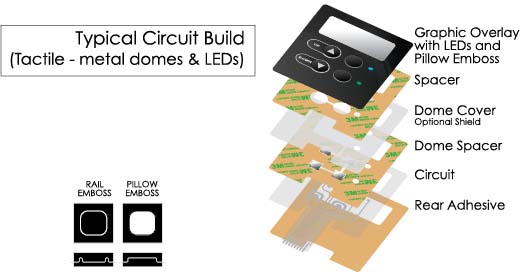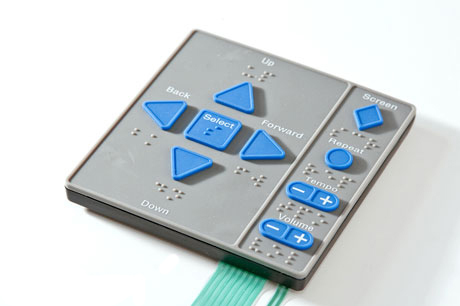How Membrane Switches Are Shaping the Future of Electronic Interfaces
How Membrane Switches Are Shaping the Future of Electronic Interfaces
Blog Article
Recognizing Membrane Changes: The Key to Sturdy and Trustworthy Controls

What Are Membrane Buttons?
Membrane switches are a sophisticated solution in the realm of user interface modern technology, combining functionality and style effortlessly. These tools function as a user interface in between customers and digital systems, integrating several components into a compact format. Usually built from versatile, slim layers of products, membrane layer buttons are created to react to touch, allowing individuals to engage with equipment and electronic gadgets efficiently.
The main aspects of a membrane switch include a printed circuit layer, graphic overlay, and a spacer layer that prevents unintended activation. The visuals overlay can be tailored to mirror brand name identity or user preferences, boosting visual appeals while guaranteeing usability. Membrane layer buttons are frequently utilized in numerous applications, consisting of medical devices, customer electronic devices, and industrial equipment, owing to their durability and resistance to ecological aspects such as wetness and dust.
Among the crucial advantages of membrane layer buttons is their ability to withstand damage, making them optimal for high-traffic environments. In addition, they are light-weight and require marginal area, enabling cutting-edge styles in item advancement. Overall, membrane layer switches stand for a effective and practical selection for contemporary digital interfaces, weding innovation with user-centric layout principles.
Just How Membrane Switches Work
The operation of membrane switches over joints on a simple yet efficient system that converts individual input right into electronic signals. When a customer presses the switch, the top layer flaws, permitting a conductive component in the circuit layer to make contact with a corresponding conductive pad on the bottom of the graphic overlay.
The style of membrane layer buttons can differ, however they typically incorporate domes or tactile components to provide feedback to the user, improving the general experience - membrane switch. The materials made use of in membrane layer buttons, such as polyester or polycarbonate, add to their resilience and resistance to environmental aspects, including wetness and dirt. In addition, the printed circuits are generally encapsulated, which shields them from wear and tear gradually.
Benefits of Membrane Layer Switches

Additionally, membrane layer switches are recognized for their sturdiness. Built from robust products, they are resistant to dirt, wetness, and physical wear, which substantially expands their lifespan compared to conventional mechanical buttons. This durability makes them especially appropriate for high-traffic environments and applications calling for long life.
Another substantial advantage is the ease of cleaning and upkeep. The smooth surface of membrane switches useful reference over decreases dirt build-up and is frequently unsusceptible spills, making them perfect for setups that need frequent sanitization.
Moreover, membrane layer buttons use a structured profile, bring about a thinner layout that can be integrated into various gadgets without adding bulk. This attribute not just boosts the aesthetic appeal yet also contributes to a much more ergonomic product style.
Applications of Membrane Layer Buttons
Easy to use and functional, membrane switches discover applications throughout a wide variety of markets, consisting of clinical devices, consumer electronic devices, and commercial equipment. In the clinical area, these buttons are important to tools look at this now such as diagnostic tools, individual tracking systems, and infusion pumps, where integrity and ease of cleaning are vital. Their capability to preserve and hold up against severe atmospheres performance makes them optimal for such applications.

In consumer electronics, membrane buttons are utilized in items like microwaves, washing devices, and push-button controls - membrane switch. Their smooth design enables instinctive interface, enhancing the total individual experience while giving durability and resistance to tear and put on
Commercial tools also gains from membrane layer switches, especially in control panels for equipment and automation systems. These buttons provide protection against dirt and dampness, making certain consistent performance in difficult environments. In addition, their adjustable functions allow manufacturers to tailor them to particular functional demands, enhancing efficiency and functionality.
Choosing the Right Membrane Layer Switch Over
When selecting a membrane button, it is necessary to consider different aspects that affect performance and viability for certain applications. The main factors to consider consist of ecological problems, tactile comments, click for info durability, and design specifications.
First, evaluate the operating atmosphere; switches revealed to moisture, chemicals, or extreme temperature levels require details materials to ensure durability and capability. Next off, examine the requirement for tactile feedback. Relying on individual communication, some applications might profit from a tactile response to validate activation, while others might prefer a non-tactile layout for aesthetic factors.
Durability is one more important element; membrane switches must be made to hold up against constant use, influences, and abrasion. Ensure the selected switch can endure the expected lifecycle, especially in high-usage circumstances.

Verdict
Finally, membrane switches over work as necessary components in the layout of sturdy and trustworthy control systems throughout various industries. Their compact layout, integrated with robust building and construction and personalized functions, boosts individual communication while ensuring longevity popular settings. The flexibility of membrane layer changes enables for customized services that satisfy specific operational demands, reinforcing their value in modern technology. As markets remain to progress, the significance of incorporating efficient membrane switch options can not be overemphasized.
Membrane layer switches over represent an essential element of modern interface layout, blending functionality with strength in numerous applications.Membrane buttons are an advanced service in the world of individual interface technology, incorporating capability and layout effortlessly. Commonly constructed from versatile, slim layers of products, membrane buttons are designed to respond to touch, making it possible for customers to engage with machinery and digital devices efficiently.
The layout of membrane layer buttons can differ, but they frequently include domes or responsive aspects to supply feedback to the customer, boosting the total experience.In final thought, membrane layer changes serve as crucial parts in the layout of resilient and trustworthy control systems across numerous markets.
Report this page